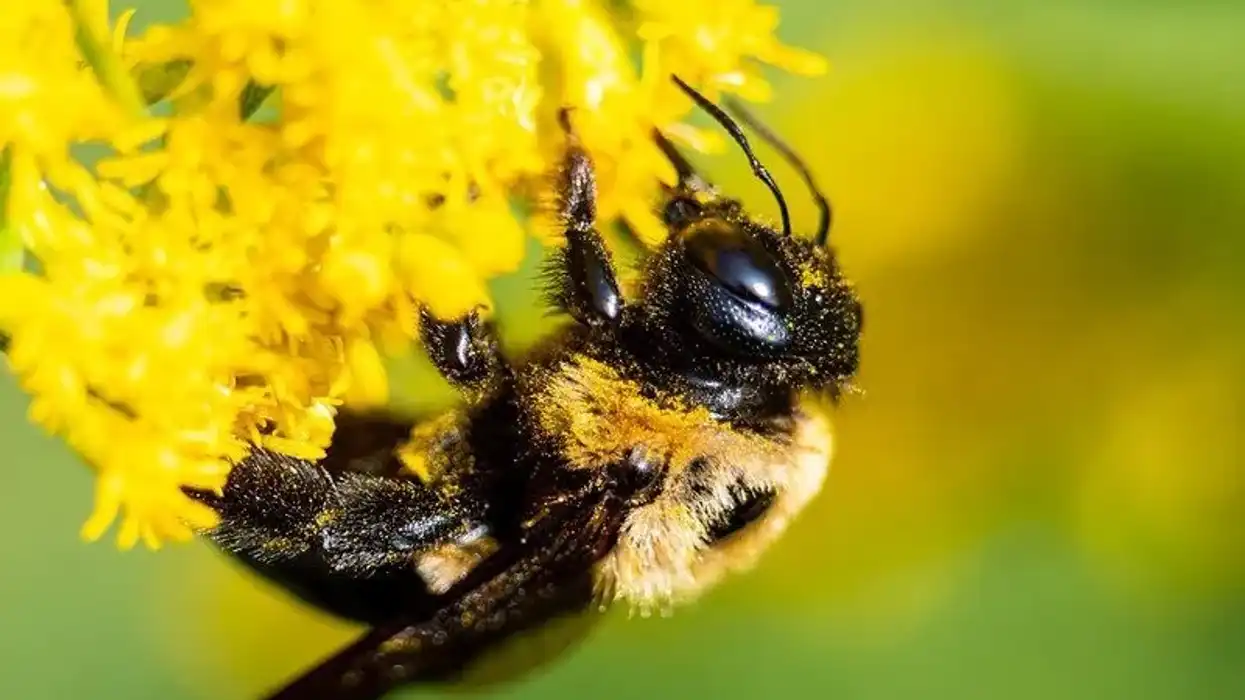After the honey bees, sweat bees, also known as Halictidae are the largest family of bees. The origin is not clear but these bees can easily be found throughout the world but the population of sweat bees in the United States and different parts of Africa is considerably high.
More than 40 species are found alone in Florida, United States.
There are multiple species of sweat bees and can be seen in different colors such as metallic green with the black and yellow abdomen, blue, and some even are red in color.
Sweat bees are generally small in size. A different sweat bee species found in the regions of the Western Hemisphere are nocturnal and are only active at night.
The primary reason for naming the bee, 'sweat bee' was that the bee is often attracted to animal and human sweat or perspiration. The primary sweat bee food is pollen and nectar but these lack additional nutrients that are required for a sweat bee.
A sweat bee requires moisture and salt and that is why they are attracted to sweat. The bees are usually present in gardens, farms, among animals and live under the soil.
Primarily, solitary sweat bees dig burrow under the soil. Also, when we compare all the species of bees, sweat bees one of the smallest.
Keep on reading to learn more interesting things about sweat bees. If you want to know more exciting information about different animals, check out the Africanized bees and Christmas beetle.
Sweat Bee Interesting Facts
What type of animal is a Sweat Bee?
A Sweat bee is an insect that lives in large communities.
What class of animal does a Sweat Bee belong to?
The Sweat bee is a member of the class Insecta of the order Hymenoptera and the Halictidae Family, with the genus Lasioglossum.
How many Sweat Bees are there in the world?
The exact population of Sweat bees is not known but scientific studies show that the bees are present across the world. In western countries like Canada, the numbers of species are high, and according to a study, more than 40 species thrive in Florida.
But one of the species found in a prominent state of the United States, California, has been listed as endangered.
Where does a Sweat Bee live?
A Sweat bee generally lives everywhere but can easily be found in Canada, the United States, especially in Florida, and many countries of Africa.
What is a Sweat Bee's habitat?
A Sweat bee habitat could be anything like fields, vegetable gardens, grasslands, roadsides, rotting wood, plant. This species can certainly be spotted in the flowers for pollen during the summer season. A Sweat bee burrows holes and lives under the soil and is also aggressive about its burrows compared to honeybees.
Who do Sweat Bees live with?
The Sweat bees are primarily eusocial or solitary. A few of the species do make colony or group but within a group, they perform particular roles and tasks. The eusocial and solitary bee generally lives in its own cell. Also, depending on the time of year these bees turn solitary or eusocial.
How long does a Sweat Bee live?
Unlike other species of bee, the lifespan of a sweat bee is around three to four months. Usually, many species of bee live for around 20-30 days, and according to a scientific study it has been proven that in a year more than two or three generations of the insects takes birth.
How do they reproduce?
The process of producing offsprings is the same as other bees and insects. The primary role of males is mating.
The males or drones are only to mate 7-10 times as they die after that as their endophallus gets removed from the body. Females, also known as the queen, mate with numerous drones during the flight.
After the flight, a queen usually stores more than 100 million sperms within her oviducts.
Queens primarily dig burrows inside the ground, cut the cell, and release an egg along with pollen. After some time, the egg turns into larvae and then pupae.
Once the pupae stage is over, worker bees come out of the eggs and it takes around 20-40 days for eggs to mature and turn into an adult. The primary role of worker bees is to dig multiple burrows under the soil so that gyne can cut the cell and lay eggs.
What is their conservation status?
The Sweat bees can easily be found in almost every country and they thrive in temperate regions. In western countries such as America and Canada, more than 1000 species of sweat bees were found.
Out of these 1000 species, around 50 are found in Florida, America. But one of the species found in California is classified as an endangered species.
Sweat Bee Fun Facts
What do Sweat Bees look like?
The green metallic body of the sweat bee and the lower part of the body has yellow and black markings, the hair is also visible on the body of the insect. The small size of sweat size makes them more beautiful and attractive.
How cute are they?
The sweat bees are very small in size and people generally confuse them with flies or ants. The bee species are primarily found in green metallic color and look more vibrant and shiny. The bees also have yellow markings that make them more attractive. Also, they usually do not attack humans.
How do they communicate?
Like other bees, the sweat bees use two basic methods of communication and through movements and sense of smell, they communicate. By using these methods bees get to know about food, mating partner, and danger.
How big is a Sweat Bee?
These Green sweat bees are one of the smallest species in the world but they are eight to nine times bigger than Euryglossina, also known as Quasihesma, that is found in Australia. Also, sweat bees are five times bigger than the Perdita minima, a native bee species of North America.
How fast can Sweat Bees move?
These bees are one of the fastest bees and the average speed of a sweat bee is 17-20 mph (24-28 kph). A few of the sweat bee species fly at a very high speed during dusk.
How much does a Sweat Bee weigh?
These bees are generally very small in size and an average adult Sweat Bee weighs around 0.00018-0.00026 lb (86-121 mg).
What are their male and female names of the species?
The male sweat bees are known as drones whereas the female sweat bees are known as queens.
What would you call a baby Sweat Bee?
We would call a baby sweat bee larvae.
What do they eat?
The sweat bee diet is the same as other species, primarily the sweat bees prey on pollen and nectar. Many of them also consume pollinating flowers. The bees also lick different wild animals to consume salt and some even try to get it from human sweat too.
Are they harmful?
The Sweat bees are not at all dangerous but often get disturbed and annoyed by humans and in such situations, the bee could use its sting. The sting is also very allergic for humans.
The female sweat bees are quite aggressive as compared to the male bees. During summers, they often get attracted to humans to fulfill their salt requirement.
Would they make a good pet?
Unlike most insects, these bees are solitary insects and generally do not like to be petted. But people often keep the bees in commercial farms as, through the sweat bees, the agricultural productivity also increases as they are beneficial in the pollination of crops. Also, the sting could cause allergies to humans.
Did you know...
Sweat bees have no ability to hover and cannot remain suspended in the mid-air for a long period of time.
A sweat bee has a major role to play in farms and agricultural fields. They primarily pollinate the indigenous plants where they dwell. The female sweat bees play a significant role in carrying pollen on their back and pollinate different plants such as sunflowers, wildflowers, Medicago sativa, and many more.
Sweat bees are best known for their metallic green structure and play a significant role in the pollination of local plants. Many of us do not know that indirectly bees are also responsible for what we eat.
For the production of seeds, pollination is required and the job is done by these bees.
Pollen is yellow in color and green sweat bees transfer the pollen from the male part of the flower to the female part of the flower which causes the implantation of the plant ovaries and seed production. Also, throughout the world, bees are recognized as prominent insect pollinators.
Hoverfly vs Sweat Bee
Hoverflies are often confused with Sweat bees as the size of both insects is almost the same. The major difference between both is that the former are flies and the latter belongs to the family of bees.
Hoverflies mimic honeybees and wasps but they do not possess any sting whereas sweat bees have a sting.
The other difference is that a hoverfly is yellow and black in color and they only have a single pair of wings while the body of sweat bees are of metallic green and have double pair of wings.
Also, sweat bees, as the name suggests are attracted to animal and human sweat while the hoverflies can easily be found around flowers, soybean, and cornfields.
All about Sweat Bee stings
Sweat bees are less aggressive to humans as compared to other species of bees. We should be scared of the sweat bee sting even though these bees are also very small in size, so their stings would also be small, but if you get stung accidentally you might have to face mild reactions and some also get allergies.
When you get stung by a sweat bee, your affected part of your body would start burning for a few seconds. The surface of your skin would turn red and you would feel a bit of pain and itchiness for a while.
If proper care is taken after you get stung, the effect would be less, and if avoided then the allergy, pain, and swelling would last for up to six to seven days.
Here at Kidadl, we have carefully created lots of interesting family-friendly animal facts for everyone to discover! Learn more about some other arthropods including the puss moth, or bombardier beetle.
You can even occupy yourself at home by drawing one on our Sweat bee coloring pages.










